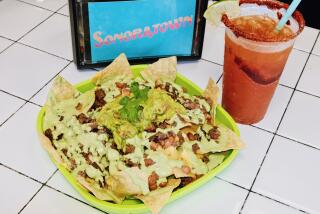Moving beyond cerveza lite
Last fall I spent a month living in San Miguel de Allende, a beautifully preserved colonial town in the central highlands northwest of Mexico City. I rented a slightly untidy house from an American documentary filmmaker and agreed to take care of her two exotic cats -- the Bengal Boys, she called them -- in exchange for a slight discount on the rent.
Here was my routine: The Boys would roust me from my cramped quarters around 8 and, skipping breakfast, I’d write until 1 or 2. Then I’d leave the napping cats and, feverishly thinking about where to eat, head up Aldama, a narrow, pitted cobblestone street bustling with vendors selling bags of fresh jicama jazzed up with squirts of picante sauce, cups of sliced melon and Mexican papaya and, my favorite, roasted corn on the cob, slathered in mayonnaise and chile powder, that was hawked by an ancient woman who advertised her wares by singing out “E-lo-te-e-e-e.”
Food -- even street food -- is serious business in Mexico, as evidenced by one of its oldest traditions, the comida, or midday meal, which is as much a social event as a dining opportunity.
Many an afternoon I sat in the shade of the laurel trees in the Jardin, the center of San Miguel, listening to locals and expats discussing ad infinitum where to take comida that day. Were they hungry enough for the five-course meal at Posada Carmina or should they, perhaps, go to the fine restaurant at La Puerticita and have a bowl of crema de poblano followed by the chef’s well-known marinated skirt steak, topped with roasted chiles and a spicy enchilada sauce -- or perhaps his equally admired chicken breast in green mole?
Such decisions would take time and some serious consideration -- claro. So they would sit hunched over the wrought-iron benches discussing their options until someone would suggest sending an emissary -- usually one of the young boys selling the local paper in the Jardin -- down the street to this restaurant or that to find out what was the special or soup of the day.
What to drink?
My selection process was simpler. I generally rotated among three or four nearby restaurants with simple but authentic and inexpensive Mexican dishes. One of my favorites was a clean little restaurant just off Insurgentes called La Enchilada. The walls were painted in bright strips of cobalt blue and dusky red, the wooden tables and chairs an aquamarine. There was no menu. If you asked for one, the owner, Senora Claudia del Carpio, would shrug her shoulders and tell you it was not necessary. The menu was the same every day: chicken or cheese enchiladas smothered in either red or green sauce, or the house specialty, mole.
The selection of beverages was just as simple: Pepsi, Fanta or Negra Modelo. All right, yes, if you insisted she also had other Mexican beers -- Sol and Corona -- but those were only for the pig-headed Americanos who knew no better, not for the true aficionados. More than once I saw Senora del Carpio raise a single eyebrow and frown when a diner ordered the pollo enchilada con mole and a Sol. “Are you certain?” she would ask about their beer selection. If they insisted that, yes, they wanted a Sol, she’d walk away from the table in disgust, shaking her head.
Mexican beer long ago surpassed European brews as the American import of choice. Corona, the leading American import, sells more than 90 million cases a year; it surpassed the leading European import, Heineken, a decade ago and now accounts for more than double the sales of the Dutch brand.
Perhaps our favorite south-of-the-border cervezas have done so well here because they seem so familiar to us. Is there really any taste difference between Coors and Sol, or Bud Light and every sorority girl’s favorite, Corona Light?
Not really. Which shouldn’t be big news, considering that Grupo Modelo, the brewer behind Corona and Corona Light as well as Pacifico, is mostly owned by the Clydesdale-prancing folks at Anheuser-Busch, makers of America’s favorite beers, Bud and little Bud. In fact, the marketers behind Corona have been so successful with the brand that not only is it the No. 1 import in the U.S., but it’s now the seventh most popular beer throughout the country -- and rising.
If you tell that to Senora del Carpio at La Enchilada, she will smile and tell you a joke. “What do Corona and making love in a rowboat have in common?” she will ask. The answer has something to do with both being very close to water.
Actually, one could substitute the name of just about any Mexican beer in the joke and the punch line would be the same. That’s because almost all Mexican beers, with a couple of notable exceptions, are brewed as light-bodied lagers similar to American and Canadian beers.
There are only two major breweries in Mexico. Grupo Modelo which, in addition to Corona, Corona Light and Pacifico, also brews Negra Modelo and Modelo Especial, a Pilsener with just a little more heft than Corona. Negra Modelo is the only dark, malty Vienna-style lager in the bunch; it’s a good match for spicy, complex Mexican dishes such as mole, which is why Senora del Carpio serves it at her restaurant. (Grupo Modelo also makes a few lesser-known lagers, available primarily in Mexico: Victoria, Estrella, Leon and Montejo beer.)
The other brewing giant, FEMSA (partially owned by Interbrew, a Belgian concern responsible for Beck’s, Stella Artois, Labatt and dozens of other imports), accounts for most of the other Mexican beers that are popular in the U.S.: Tecate, Dos Equis, Sol and Bohemia. And like Grupo Modelo, FEMSA prefers to make light lagers (with the exception of Noche Buena, a dark, rich beer that is available only during the winter holidays).
Not that there’s anything wrong with any of these beers. In fact, when you’re chilling off the Baja coast, thinking about little more than a quick swim followed by a nap in the hammock, as is suggested by more than one Corona commercial, a cool, light beer that is as refreshing as sparkling water, with a little lime tossed in to give it some taste, is just the ticket.
But if you’re tucking into the mole enchiladas at Senora del Carpio’s restaurant or the cochinita pibil -- a spicy marinated pork tarted up with grilled onions, orange and cinnamon -- at the Border Grill in Santa Monica, Corona, or any typical Mexican beer for that matter, is out of the question.
So what are your options? You can order Bohemia which, though still a lager, is aged longer than most Mexican beers and has some body to it, or a Negra Modelo, whose thick, brown, chocolaty taste beer critic Michael Jackson calls “the perfect accompaniment to chicken mole.”
Or, if you really want to look like you know what you’re doing, you can opt for a Casta, a little-known but greatly heralded beer from an up-and-coming craft brewer, Especialidades Cerveceras. The Monterey, Mexico, brewery is the only one in the country that makes ales, and what ales they make. Mauricio Fernandez and Manuel Zambrano, brothers-in-law, have been brewing beer for years (the Fernandez family established one of the first Mexican breweries in 1890), but it wasn’t until 1998 that they decided what was missing in most Mexican beers was the hearty, flavorful robustness of the best European brews.
Hence Casta, which roughly translates as “pure” or “pedigreed” and is a discreet nod to the brewery’s adherence to German brewing standards. The line includes four ales: Dorada, Bruna, Morena and Triguera. The most popular, Bruna, is a copper-colored beer similar to the English Bass Ale. Well-balanced and very smooth, it’s probably the most versatile of the Casta line as far as food pairings, though it really lends itself to pastor dishes, chicken adobado and the salsa-heavy huachinango, or red snapper, Veracruz.
A match for mole
Several tasters in The Times Test Kitchen also thought Bruna was the best match of the Casta beers with many moles, though my personal pick was Morena, a complex beer made with six malts -- including caramel and chocolate -- that most resembles those oatmeal-thick Scottish ales that almost seem like liquid desserts. Its heartiness makes it a good match for chorizo or pork dishes as well as skirt steak marinated in garlic, cilantro, cumin and lime. You might also try it instead of port with a cheese plate.
Dorada, with its excellent hoppy nose, seems perfectly suited to typical Mexican antojitos such as tacos, enchiladas and grilled chicken marinated in lime juice. The lightest of the ales, Triguera, is what the Germans call a Weissbier, wheat beer. If you really don’t like robust beers, try this. It’s well-suited to a summer party or a day around the pool when you feel like breaking out of the Corona doldrums. It goes great with simple Mexican dishes -- fish tacos, ceviche, shrimp or lobster, as well as grilled steaks or hamburgers.
Casta has been in the U.S. market only since 2001, so its availability is limited but growing. According to its U.S. distributor, David Smith, the two bestsellers, Bruna and Morena, are available in all Beverages & more! locations, though we had difficulty finding it in some outlets (Smith blames that on an inventory glitch). Dorada should start coming into stores in April. Trader Joe’s might start carrying the brand, Smith says, and it’s available at better wine and liquor shops, including Hi-Time in Costa Mesa, as well as a few restaurants -- Avila’s Grill in San Clemente and the Border Grill in Las Vegas.
Despite the difficulty in actually finding Casta, it’s already developed a bit of a cult following among beer aficionados, particularly in Southern California, where devotees have been known to embark on road trips to Tijuana or jaunts to Los Cabos in search of what many think is by far the best beer brewed in Mexico. Its spotty distribution may be a bit behind the curve, but its superior matchup with food -- particularly Mexican food -- makes it el numero uno to Mexican beer lovers. Best of all, you don’t need to throw a lime in to kick-start its taste.
More to Read
Sign up for The Wild
We’ll help you find the best places to hike, bike and run, as well as the perfect silent spots for meditation and yoga.
You may occasionally receive promotional content from the Los Angeles Times.






